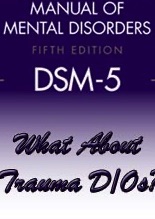Trauma Diagnosis
101Trauma
There is no greater agony than bearing an untold story inside you.
~Maya Angelou

Treatment is Based on Diagnosis;
We Need Better Options
Differential Diagnosis
Simple PTSD vs.
Complex PTSD vs.
Developmental Trauma Disorder (DTD)
Simple Post-Traumatic Stress Disorder (PTSD)
Simple Post-Traumatic Stress Disorder (PTSD) develops after a terrifying ordeal that involved physical harm or the threat of physical harm. The person who develops PTSD may have been the one who was harmed, the harm may have happened to a loved one, or the person may have witnessed a harmful event that happened to loved ones or strangers. PTSD was first brought to public attention in relation to war veterans, but it can result from a variety of traumatic incidents, such as mugging, rape, torture, being kidnapped or held captive, child abuse, car accidents, train wrecks, plane crashes, bombings, or natural disasters such as floods or earthquakes. People with PTSD may startle easily, become emotionally numb (especially in relation to people with whom they used to be close), lose interest in things they used to enjoy, have trouble feeling affectionate, be irritable, become more aggressive, or even become violent. They avoid situations that remind them of the original incident, and anniversaries of the incident are often very difficult. PTSD symptoms seem to be worse if the event that triggered them was deliberately initiated by another person, as in a mugging or a kidnapping. Most people with PTSD repeatedly relive the trauma in their thoughts during the day and in nightmares when they sleep. These are called flashbacks. Flashbacks may consist of images, sounds, smells, or feelings, and are often triggered by ordinary occurrences, such as a door slamming or a car backfiring on the street.
Read Seminal paper by Bessel van der Kolk
Complex Post-Traumatic Stress Disorder (C-PTSD)
According to Judith Herman:
Even the diagnosis of 'post-traumatic stress disorder', as it is presently defined, does not fit. The existing diagnostic criteria for this disorder are derived mainly from survivors of circumscribed traumatic events. They are based on the prototypes of combat, disaster, and rape. In survivors of prolonged, repeated trauma, the symptom picture is often far more complex. Survivors of prolonged abuse develop characteristic personality changes, including deformations of relatedness and identity. Survivors of abuse in childhood develop similar problems with relationships and identity; in addition, they are particularly vulnerable to repeated harm, both self-inflicted and at the hands of others. The current formulation of post-traumatic stress disorder fails to capture either the protean symptomatic manifestations of prolonged, repeated trauma or the profound deformations of personality that occur in captivity. The syndrome that follows upon prolonged repeated trauma needs its own name. I propose to call it 'complex post-traumatic stress disorder’. The responses to trauma are best understood as a spectrum of conditions rather than as a single disorder. They range from a brief stress reaction that gets better by itself and never qualifies for a diagnosis, to classic or simple post-traumatic stress disorder, to the complex syndrome of prolonged, repeated trauma. As the concept of a complex traumatic syndrome has gained wider recognition, it has been given several additional names. The working group for the diagnostic manual of the American Psychiatric Association has chosen the designation, Disorder of Extreme Stress not Otherwise Specified.
Proposed Diagnostic Criteria for Complex Post-Traumatic Stress Disorder
A History of subjection to totalitarian control over a prolonged period (months to years). Examples include hostages, prisoners of war, concentration camp survivors, and survivors of some religious cults. Examples also include those subjected to totalitarian systems in sexual and domestic life, including survivors of domestic battering, childhood physical or sexual abuse, and organized sexual exploitation.
1. Alterations in Consciousness, including:
Amnesia or hypermnesia for traumatic events.
Transient dissociative episodes.
Depersonalization/derealization.
Reliving experiences, either in the form of intrusive post-traumatic stress disorder symptoms or in the form of ruminative preoccupation.
2. Alterations in self-perception, including:
Sense of helplessness or paralysis of initiative.
Shame, guilt, and self-blame.
Sense of defilement or stigma.
Sense of complete difference from others (may include sense of specialness, utter aloneness, belief no other person can understand, or non-human identity).
3. Alterations in perception of perpetrator, including:
Preoccupation with relationship with perpetrator (includes preoccupation with revenge).
Unrealistic attribution of total power to perpetrator (victim’s assessment of power realities may be more realistic than clinician’s).
Idealization or paradoxical gratitude.
Sense of special or supernatural relationship.
Acceptance of belief system or rationalizations of perpetrator.
4. Alterations in relations with others, including:
Isolation and withdrawal.
Disruption in intimate relationships.
Repeated search for rescuer (may alternate with isolation and withdrawal).
Persistent distrust.
Repeated failures of self-protection.
5. Alterations in systems of meaning:
Loss of sustaining faith.
Sense of hopelessness and despair.
Naming the syndrome of complex post-traumatic stress disorder represents an essential step toward granting those who have endured prolonged exploitation a measure of the recognition they deserve. It is an attempt to find a language that is at once faithful to the traditions of accurate psychological observation and to the moral demands of traumatized people. It is an attempt to learn from survivors, who understand, more profoundly than any investigator, the effects of captivity.
~Trauma and Recovery, Judith Herman,1992
Developmental Trauma Disorder (DTD)
Click here to read Developmental trauma disorder by Bessel A. van der Kolk, MD
